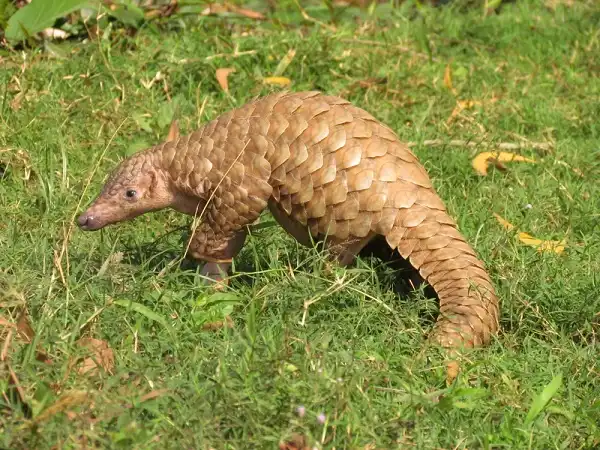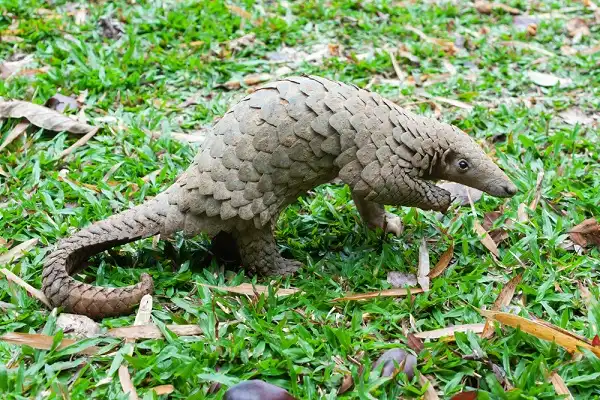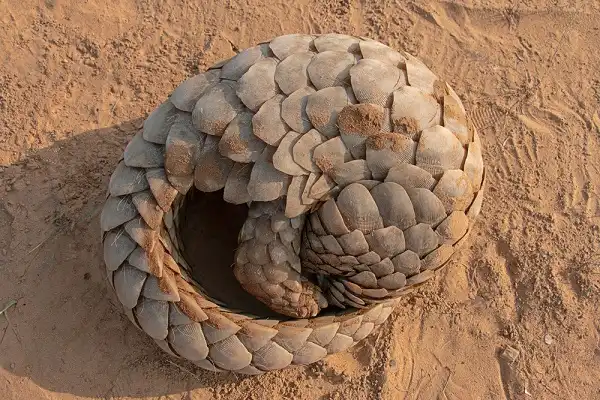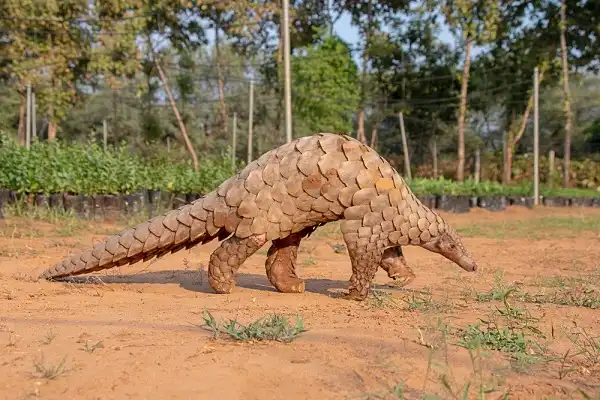If you were to see a pangolin for the first time, it might be difficult to comprehend what this animal is. With scale-covered skin and a long snout, pangolins look unlike any other mammal on earth – and they couldn’t be more unique! From the scales covering its body to their diet of mainly ants and termites, these creatures possess some extraordinary traits that could leave many people scratching their heads in awe. In this blog post, we will delve into the captivating characteristics of pangolins so you can learn more about one of nature’s most unusual animals.

Pangolin Description
Pangolins, also known as scaly anteaters, are fascinating creatures that belong to the family Manidae. They are unique in appearance, with their scaled skin and a long snout that they use to sniff out their prey. The scales that cover a pangolin’s body are made of keratin, the same material that makes up hair and nails in humans. These scales provide excellent protection against predators, making it difficult for them to penetrate the pangolin’s skin. When threatened, a pangolin can roll into a ball, with its overlapping scales acting as armor. This behavior makes the pangolin the only mammal in the world that can roll into a ball for protection. Pangolins are solitary animals that are mostly active at night. They have poor eyesight but a highly-developed sense of smell, which they use to locate their prey. Their diet consists mainly of ants and termites, which they obtain using their long, sticky tongues.
Pangolin Habitat
Pangolins are found in a number of different habitats, including tropical forests, grasslands, and scrubland. They inhabit areas where they can find plenty of ants and termites to feed on. Depending on the species, pangolins may be found in Africa or Asia. In general, pangolins prefer to stay close to the ground and out of sight from predators. They make their homes in burrows dug into the soil or hollow logs and tree stumps. These underground dwellings provide protection from potential danger and help regulate their body temperature during warmer months.
Pangolin Diet
Pangolins primarily feed on ants and termites, which they obtain using their long, sticky tongues. Their tongues are so long that they can reach up to 40 centimeters in length! They also eat a variety of other insects such as beetles, larvae, and even honey bees. In addition to their insect diet, pangolins may also consume fruit and vegetables if they come across them while foraging. The exact composition of their diet depends on the species and where in the world they live.
Pangolin Size
Pangolins come in a variety of sizes, depending on the species. Fully-grown pangolins can measure up to 1 meter in length and weigh around 15 kilograms, but some species are much smaller. For example, the Sunda Pangolin is only about 60 centimeters long and 3 kilograms in weight. No matter their size, the scales that cover a pangolin’s body are made of keratin, the same material that makes up hair and nails in humans. These overlapping scales provide excellent protection against predators, making it difficult for them to penetrate the pangolin’s skin.

Pangolin Lifespan
The average lifespan of a pangolin is around 15 to 20 years in the wild. In captivity, however, they can live up to 30 years if properly cared for. Like many animals, their lifespans are heavily influenced by their diet and habitat. Pangolins that live in areas with plentiful food sources tend to have longer lifespans than those living in more hostile environments. Ultimately, the best way to ensure that these incredible creatures live long, healthy lives is by protecting them from illegal hunting and poaching. With our help, pangolins will continue to inhabit the earth for generations to come.
Pangolin Behavior
Pangolins are relatively solitary creatures that tend to keep to themselves. They largely remain inactive during the day, and usually come out at night to find food. These animals also have a few defenses against predators: they can curl up into a tight ball, making it difficult for most predators to get through their scaly armor; they release a foul-smelling liquid from glands near their tails when threatened; and they will hiss or screech loudly in an attempt to scare away potential threats. In addition, pangolins are surprisingly good swimmers! When faced with danger on land, they can escape by diving into nearby water sources and swimming away from harm.
Pangolin Speed
The fastest pangolin is the African White-bellied Pangolin, which can run up to 18 kilometers per hour when threatened. However, this species is fairly rare and most of the other pangolin species are not as fast. In general, pangolins are slow on land due to their heavy bodies and scaly armor. They do move more quickly in water, where they can use their powerful tails to propel themselves forward. Despite their slow speed on land, pangolins have a remarkable capacity for sniffing out food sources from miles away! Their highly developed sense of smell helps them locate ants and termites underground with ease.

Pangolin Hunting
Pangolins are unique creatures that have evolved to hunt and eat ants and termites. They use their long, sticky tongues to capture insects from as far away as 20 centimeters underground! Their scales provide excellent protection from predators, but they can also be used offensively in hunting. When faced with a large group of ants or termites, pangolins will curl up into a tight ball and roll around, crushing the insects beneath them! This technique can help them gather large amounts of food quickly and efficiently. However, pangolins do not use this method exclusively; they also feed on fruit, eggs, and other small animals as well. Unfortunately, pangolins are also one of the most trafficked animals in the world. Their scales and meat are highly valued in some cultures for their supposed medicinal properties, and their meat is considered a delicacy in some countries. This illegal trade has pushed pangolins to the brink of extinction, with all eight species of pangolins listed as either endangered or critically endangered.
Pangolin Predators and Natural Threats
Pangolins have a few predators in the wild, including humans who hunt them for their meat and scales. Other predators include large cats, raptors, and even monitor lizards! In addition to these threats, pangolins are facing an increasing amount of habitat destruction due to deforestation and other human activities. This can limit their access to food sources, as well as put them at risk from poachers. Therefore, it is important that we protect these creatures by raising awareness about their plight and taking steps to conserve their habitats around the world. With our help, pangolins can continue to inhabit the earth for generations to come.
Pangolin Reproduction and Parental Care
Pangolins usually mate during the rainy season, and after a gestation period of up to 150 days, the female will give birth to 1-3 young. The babies are born blind and helpless, so their mothers take extra care in keeping them safe from predators. The mother will carry her young on her back for the first few months until they are old enough to venture out by themselves. During this period, she will dedicate all of her time and energy to teaching them how to hunt for food and defend themselves against potential threats. Eventually, the young pangolins will become independent and leave their mother’s side. They can then continue life as adult pangolins with all of the tools they need to survive.

Conclusion
Pangolins are fascinating animals with a unique set of adaptations that allow them to survive in their environment. Their behavior includes defensive strategies such as curling up into a ball and releasing foul-smelling liquid from glands near their tails. They also possess an impressive sense of smell which helps them locate food sources from miles away. Despite their slow speed on land, pangolins are surprisingly good swimmers and use this ability to escape danger when necessary. They also hunt by rolling around and crushing insects beneath them!
Frequently Asked Question


